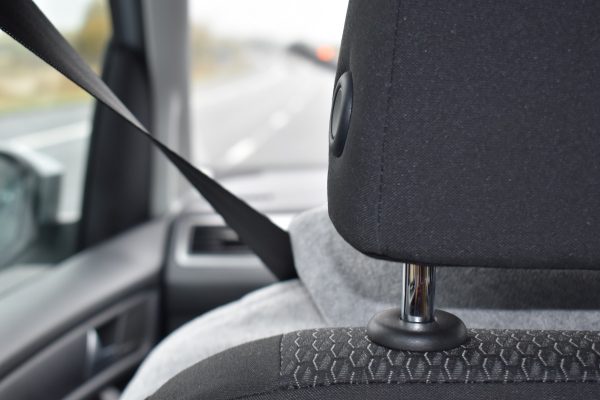A guide to seat belt law for classic cars

Everyone knows you need to wear a seat belt when travelling in a car, but seat belt laws get a little more confusing when it comes to classic cars.
Here we answer all your frequently asked questions about seat belt laws and classic cars.
Do classic cars need to have seat belts in the UK?
If a classic car was originally manufactured without seat belts, then it currently does not need to have seat belts fitted. Many cars were manufactured without them prior to the legislation being introduced in 1983.
However, according to guidance provided by the DVLA, without seat belts, the types of passengers you can carry in your vehicle is limited.
There are restrictions to transporting children, with no children under the age of three permitted to travel in a car without seat belts. Children over the age of three can travel in the car but are only allowed to sit in the back seats.
What year of car is exempt from seat belts?
If your car was made before 1965 and seat belts were not fitted at the point of manufacture, you are not required to fit them.
In the UK, it became compulsory for manufacturers to install anchorage points in vehicles in 1965, with the requirement for three-point belts in the front outboard positions following three years later. The 1968 legislation necessitated that all new vehicles be fitted with seat belts, and any vehicle dating back to 1965 must be equipped with them.
My classic car doesn’t have seat belts, will this affect my insurance?
Due to the lack of this additional safety feature, classic cars without seat belts are likely to be more difficult and expensive to insure. However, insurance companies that specialise in classic vehicles can ease the process of getting your classic car insured.
Who has to wear seat belts if they are fitted?
Legislation states that if seat belts are fitted in the seat you’re using, they must be worn when the car is being driven. The law also states that only one person can sit in a seat with a fitted belt at a time.
For children, the appropriate car seat for their height or weight must be used until they reach 135cm tall or reach the age of 12, whichever is first.
Are there exemptions to the seat belt law?
There are a few exemptions to the seat belt law. For example, drivers do not have to wear a seat belt when reversing, nor does a supervisor when a learner is reversing.
You do not need to wear a seat belt if you’re in a vehicle being used for police, fire and rescue services, or are a passenger in a trade vehicle and are investigating a fault.
If you are driving a goods vehicle and there is less than 50 metres between stops then you are also exempt, as well as taxi drivers who are ‘plying for hire’ or carrying passengers.
There are also medical exemptions, but you must have a Certificate of Exemption, carried with you in the vehicle, before ditching your seat belt. You will also be required to inform your car insurer if you have an exemption.
What’s the penalty for not wearing a seat belt?
Currently in the UK, if found not wearing a seat belt when required, you could be fined up to £500. However, a recent proposal could also see drivers face points on their licence for not wearing seat belts, although the Department for Transport has not said how many.
Who’s responsible for ensuring passengers wear their seat belts?
It is the passenger’s responsibility to ensure they are wearing their seat belt, and anyone not wearing one when required could be fined up to £500. However, if the passenger is under the age of 14, the driver is responsible for ensuring they wear a seat belt or are suitably restrained. If they are caught not wearing one, the driver will face the penalty.
When did seat belts become law?
It has been a legal requirement to wear a seat belt in a car in the UK since 1983 – that’s given us 40 years to get used to it!
When did rear seat belts have to be fitted in cars?
It became compulsory for all adults to wear a seat belt in the back of a car in 1991, but there is still no compulsion to fit seat belts in cars that were manufactured without them.

Are lap belts legal?
Most manufacturers fit three-point seat belts as standard, but lap belts are legal and will increase your safety.
Three-point seat belts are safer, but wearing a lap belt is far better than wearing no seat belt at all, because the greatest risk of injury in a road accident comes from being thrown about inside the vehicle or being ejected from it.
The lap belt should go over the pelvis (not the soft stomach area) and fit as tightly as possible.
What should we know about child seat belt law?
If you carry a child under 12 or under 135cm tall, they must use either an approved child seat or child booster seat when travelling in the front or rear of any car, taxi, private hire vehicle, van or goods vehicle.
After this, they must use an adult seat belt. The driver is responsible for ensuring any child under 14 years old is restrained correctly in accordance with the law.
Does my dog need a seat belt in the car?
Rule 57 of the Highway Code stipulates: “When in a vehicle make sure dogs or other animals are suitably restrained so they cannot distract you while you are driving or injure you, or themselves, if you stop quickly.
“A seat belt harness, pet carrier, dog cage or dog guard are ways of restraining animals in cars.”
Classic car insurance from Adrian Flux
If you’re in need of classic car insurance, call Adrian Flux on 0800 369 8590 or request a callback at a time that suits you. Our classic car insurance customers saved an average of 31% in 2021 when taking out a policy with us. See how much you could save by giving us a call.
The complete guide to classic car MOT exemption







